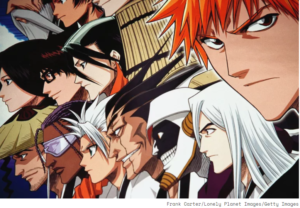The BACKGROUND to Japanese ANIMATION

In Japan, anime is pronounced “ah-KNEE-may” and is an abbreviation for animation. All Japanese animation is referred to as anime. The term has become synonymous with Japanese animation throughout the world, except in Japan.
Anime has been a local product for decades – a product produced by and for Japan, both in terms of its art and its stories. As it has become an international phenomenon over the past forty years, millions of fans have followed it, and it has been translated into many languages. In the West, it has become a part of a generation of viewers who are now passing it on to their own children.
Anime shows, like books or movies, fall into any number of existing genres: comedy, drama, sci-fi, action-adventure, horror and so on.
Why is Anime so Different?
There is a way to sum up anime in a few words: “It’s different.” Anime is as unlike most American cartoons as the comics we see in daily newspapers are different from “Batman” and “Spider-Man.” The differences are evident in many ways, from the artwork to the storytelling and even the cultural references.
As an example, “Samurai Champloo” and ” FLCL” feature flamboyant and outlandish art, while “Azumanga Daioh! ” features a simple and direct style of illustration. There’s something refreshing about anime.
There are dozens (sometimes hundreds) of episodes per season, along with epic storylines. No matter how long the anime is, the viewers must be emotionally involved with it.
An anime series can be found that matches the style of virtually any other type of TV or movie. There are several adaptions of classical literature, such as “Count of Monte Cristo,” if you’re a fan of hard science fiction. Try “Planetes” for a romantic comedy, while “Fruits Basket” for crime fighting.
Anime also gives viewers a glimpse into the centuries-old history, language, and worldview of Japan, which are all seamlessly woven into anime on many levels. “Sengoku Basara” uses references to Japanese history, and “Hakkenden” uses Japanese mythology as inspiration. “Monster,” even though it outwardly appears to be non-Japanese, is infused with a Japanese sensibility.
What’s most striking is how anime’s impact is coming full circle. Some recent American cartoon productions, like “Avatar: The Last Airbender,“ are openly inspired by anime itself, and live-action English-language versions of anime titles are starting to come into production more frequently.
What Audience does Anime attract? Is Anime OK for the Younger Ones?
In its broad subject matter, anime is accessible to a wide range of age groups. As a rule of thumb, some titles cater to younger audiences while others cater to older audiences like “InuYasha.” There are even some aimed specifically at older teens like “Death Note” and some specifically at mature audiences like “Monster” and “Queens Blade.”
Japanese cultural attitudes about sexuality and violence require some titles to be placed a category higher than they might normally be. Nudity, for instance, is handled much more casually in Japan; sometimes a show that isn’t meant specifically for adults will have material which may seem racy to Western viewers.
Anime distributors are generally quite conscious and normally respect an actual MPAA rating (G, PG, PG-13, R, NC-17) or a TV Parental Guidelines rating as an indicator of what the intended audience is for the show. Check the show’s packaging or program listing to see which rating applies.
Confused about where to start? We recommend checking out the sci-fi, cyberpunk “Cowboy Bebop” or a swords-and-sorcery tale called “Berserk.” If you already know a friend who’s an anime fan, clue them in on what you like to watch — they should be able to guide you towards what’s best and what’s new in that category.
Original article: Here

